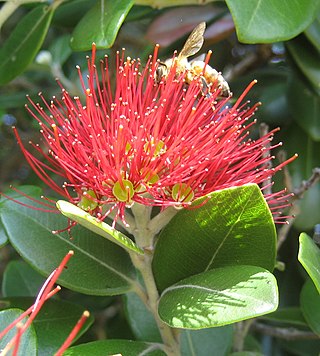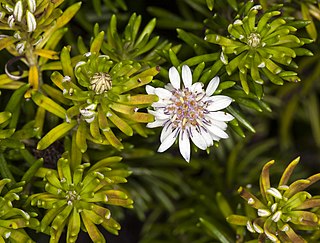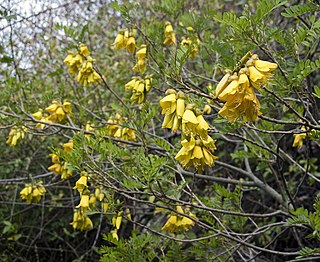
Metrosideros is a genus of approximately 60 trees, shrubs, and vines mostly found in the Pacific region in the family Myrtaceae. Most of the tree forms are small, but some are exceptionally large, the New Zealand species in particular. The name derives from the Ancient Greek metra or "heartwood" and sideron or "iron". Perhaps the best-known species are the pōhutukawa, northern and southern rātā of New Zealand, and ʻōhiʻa lehua, from the Hawaiian Islands.

Metrosideros kermadecensis, with common names Kermadec pōhutukawa and New Zealand Christmas bush is an evergreen tree of the myrtle family which is endemic to the volcanic Kermadec Islands about 900 km north-east of New Zealand. The tree produces a brilliant display of red flowers, made up of a mass of stamens and is the dominant forest tree on Raoul Island, growing to 15 m or more. The trunk is up to 1 m or more in diameter. It is very similar to, and often confused with, the pōhutukawa of mainland New Zealand, differing mainly by having smaller, more oval leaves, and by flowering throughout the year. It also resembles the ʻōhiʻa lehua of Hawaiʻi.

Cassinia tenuifolia, commonly known as bully bush or killmoke, is a species of flowering plant in the family Asteraceae and is endemic to Lord Howe Island. It is a dense, bushy shrub with hairy young stems, crowded linear leaves and sweetly scented flower heads arranged in corymbs.

Metrosideros nervulosa, commonly known as the mountain rose, is a species of flowering plant in the family Myrtaceae. It is endemic to Lord Howe Island in the Tasman Sea, part of the Australian state of New South Wales. It occurs in shrubland or low forest, mainly at altitudes of 300–875 m on the main peaks of the island. It prefers sunny positions on exposed ridges or in the forest canopy.

Olearia ballii, commonly known as mountain daisy, is a species of flowering plant in the family Asteraceae and is endemic to Lord Howe Island. It is a dense shrub with crowded linear leaves and small, purplish and white, daisy-like inflorescences.

Lepidium howei-insulae , commonly known as mustard & cress, is a flowering plant in the mustard and cabbage family. The specific epithet alludes to Lord Howe Island, where it is found.

Dracophyllum fitzgeraldii, commonly known as the Fitzgeraldii tree or Fitzgerald tree, is a flowering plant in the family Ericaceae. It is endemic to Lord Howe Island, though its closest relatives are species native to northern Queensland and to New Caledonia.

Sophora howinsula, commonly known as lignum vitae or Lord Howe kowhai, is a flowering plant in the legume family. The specific epithet refers to the island to which the species is endemic.

Cryptocarya gregsonii, commonly known as native blackbutt, black plum or laurel, is a flowering plant in the laurel family. The specific epithet honours Jesse Gregson of Newcastle, New South Wales, a botanical friend of Maiden.
Chionanthus quadristamineus, commonly known as the blue plum, is a flowering plant in the olive family. The specific epithet refers to the four stamens in the flowers.

Piper hooglandii, commonly known as kava, is a flowering plant in the family Piperaceae. The specific epithet honours Dutch botanist Ruurd Dirk Hoogland.

Coprosma huttoniana is a flowering plant in the family Rubiaceae. The specific epithet honours Ian Hutton, the Lord Howe Island based naturalist who discovered the plant and recognised it as a new species.

Coprosma prisca, commonly known as goatwood, is a flowering plant in the family Rubiaceae. The Latin specific epithet prisca means “old” or “ancient”, though its application to this species is unknown.

Coprosma putida, commonly known as stinkwood, is a flowering plant in the family Rubiaceae. The Latin specific epithet putida means "stinking", alluding to the stench produced when the plant is cut or bruised, including the leaves and fruit.
Psychotria carronis, commonly known as the black grape, is a flowering plant in the coffee family. The specific epithet honours William Carron (1823–1876) who collected plants on Lord Howe Island for the Royal Botanic Gardens, Sydney.
Exocarpos homalocladus, commonly known as the grass tree, is a flowering plant in the sandalwood family. The specific epithet comes from the Greek homalos (“flat”) and clados, with reference to the structure of the plant.
Symplocos candelabrum is a flowering plant in the sapphireberry family. The specific epithet may refer to the candelabrum-like display of stamens in the flower.
Melicytus novae-zelandiae subsp. centurionis is a flowering plant in the family Violaceae. It is a subspecies of Melicytus novae-zelandiae, known in New Zealand as coastal mahoe. The subspecific epithet honours the military Captain James Doran McComish (1881–1948), who made several visits in the 1930s to collect plants on Lord Howe Island.

Olearia elliptica subsp. praetermissa is a flowering plant in the family Asteraceae. The subspecific epithet means "overlooked", referring to the fact that this distinctive endemic subspecies was long overlooked.
Leptospermum polygalifolium subsp. howense, commonly known as tea tree or tea-tree, is a flowering plant in the myrtle family, Myrtaceae. The subspecific epithet refers to the island to which the subspecies is endemic.














